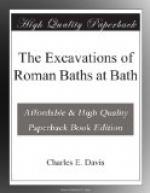This concludes the particulars of the important discoveries which we possess of the last century, which were then correctly believed to be only portions of still greater baths.[11] In 1799 (or, as I believe, in 1809, the more correct date) a portion of what has proved to be the north-west semi-circular exedra of the Great Bath was found, and six to nine years later a part of the south-west rectangular exedra of the same bath. The discovery of 1799 (or rather 1809) is shown on the Rev. Prebendary Scarth’s map as being the northern apse of a bath on the western end of the great bath, as suggested by Dr. Sutherland’s plan and was to correspond with Lucas’s Bath. The semi-circular exedra discovered subsequently to a deed dated Sept. 1808 (therefore in that year or subsequently) is also figured by the Rev. Prebendary Scarth, as on the south end of the same western bath and a piece of a rectangular exedra as the eastern wall of this western bath and the boundary between it and the Great Bath.
[Footnote 11: As there have appeared in local papers considerable discussions as to these baths, I quote from one of the letters the following as being remarkably clear and explanatory:—
“In 1755, Dr. Lucas discovered a Roman bath, east of, and immediately adjoining, the Great Bath, which is now attracting so much attention. Lucas’s Bath stood north and south—an important fact to bear in mind, as the great Roman Bath stands east and west—and measured 43ft. by 34ft. But this was not all. ‘To the north of this room,’ he says, ’parted only by a slender wall, adjoined a semi-circular bath, measuring from east to west, 14ft. 4in.’ After the publication of Lucas’s ‘Essay on Waters,’ the ground was further cleared away, and there appeared another semi-circular bath to the south, of the same dimensions as that to the north. The extreme length of Lucas’s bath—including the N. and S. Baths, exclusive of the central semi-circular recesses—would be, roughly speaking 69ft.; and this fact should be carefully borne in mind, as we shall see presently to what use it was turned. Dr. Lucas’s discoveries were pushed one stage further by Dr. Sutherland, who in his work entitled ’Attempts to revive Ancient Medical Doctrines’ (1763) clearly indicates (Pl. V.) that he was on the track of another bath, the Great Roman Bath, in fact, with which we are now so familiar. His words are as follows: ’From each, corner of the westernmost side of Lucas’s Bath, a base of 68ft., there issues a wall of stone and mortar. These walls I have traced six or eight feet westward under that causeway, which leads from the Churchyard to the Abbey Green. When, as we may suppose, they have run a length proportionable to their width, they compose a bath which may indeed be called great, 96ft. by 68ft.... From the westernmost side of Lucas’s Bath a subterraneous passage has been traced 24ft., at the end of which was found a leaden cistern, raised about 3ft. above the pavement, constantly




